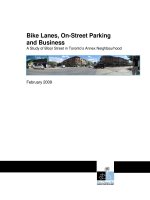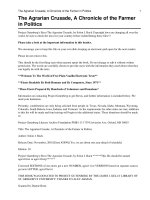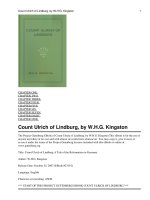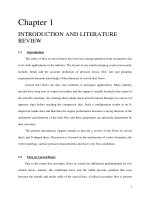A study of the flow in an s shaped duct 5
Bạn đang xem bản rút gọn của tài liệu. Xem và tải ngay bản đầy đủ của tài liệu tại đây (216.72 KB, 10 trang )
59
Chapter 5
EFFECTS OF INLET BOUNDARY LAYER
ON SWIRL DEVELOPMENT
5.1 Introduction
The swirl development and vortical structures for flows in a square cross sectioned S-
duct was investigated in detail in Chapter 4. Based on flow visualisation and cross flow
measurement at the duct exit, a flow model was proposed to explain qualitatively the changes
in flow structure in the first and second bend. To verify the validity of this flow model, cross
flow measurements at multiple planes within the S-duct was performed using a seven-hole
cobra probe. The quantitative data from this part of the work will be correlated to the flow
model and presented in the first part of this Chapter.
In the second part of the Chapter, the effects of inlet boundary layer thickness on
swirl development are investigated. Although the effects of inlet boundary layer thickness
were investigated by Taylor et al. (1982a), it was conducted at two different Reynolds
numbers of 790 and 40,000 for thick and thin boundary layers. In the present work, the
Reynolds numbers were kept constant and only the inlet boundary layer thickness was varied.
This would isolate the effects of boundary layer thickness on swirl development and on the
formation of stream-wise vortices. Details on the experimental set-up are described in the
next section.
60
5.2 Experimental Set-up
The experimental set-up is the same as that described in Chapter 2, except that only
Test Section 2 is used. Three different flow speeds were investigated, namely, at 5 m/s, 10
m/s and 15 m/s, which give Re = 4.73x10
4
, 9.72x10
4
and 1.47x10
5
respectively. For each Re,
two boundary layer thicknesses of /D = 0.05 and 0.25 were investigated. To thicken the
boundary layer, a 2 mm diameter steel wire was installed on all the four sides of the outlet of
the wind tunnel contraction. The boundary layer thickens as the flow approaches the inlet of
the S-duct and Fig. 5.1 shows the inlet velocity profile at these two boundary layer
thicknesses for three different Reynolds numbers. The results clearly show that the two
boundary layer thicknesses do not vary significantly with Re.
A seven-hole cobra probe was used to measure the 3D velocity components on
multiple internal planes within the S-duct. The data acquisition process using the Aeroprobe
System was described in Chapter 2. Fig. 5.2 shows the 9 internal planes within the S-duct
where measurements were taken. With the inlet plane denoted as Plane 1 and the exit plane as
Plane 9, the remaining Planes 2 to 8 are distributed at equal angular intervals along the S-duct
test section. Transverse slots along each plane were cut on the top wall of the S-duct so that
the cobra probe can be inserted into the duct for measurement. The probe was mounted on the
linear traversing device. All measurements were confined to a lower half of each
measurement plane, i.e. from y/D = -0.4667 to 0.4667 and z/D = -0.4667 to 0.0, at a spatial
interval of 5 mm. A 5.0 sec waiting time was allowed for the flow to stabilise before
acquiring data at each new probe position.
In the next section, quantitative data from these measurements are used to verify the
flow structures as proposed in the flow model in Chapter 4. Subsequently, the effects of inlet
boundary layer thickness on swirl development are examined through the multiple-plane
measurements.
61
5.3 Results and Discussion
5.3.1 Verification of Flow Model
For brevity, only the cross flow measurements at multiple internal planes at Re =
1.47x10
5
are selected for discussion here. The choice is based on the surface flow
visualisation conducted at the same Reynolds number, where the dividing line was
prominently seen and visualised in Chapter 4. In addition, the stream-wise vortices close to
the near-side wall consist of a counter-rotating vortex pair on which the flow model was
based.
Based on flow visualization, the proposed flow model shows that a dominant swirl
developed in the first bend of the S-duct. The cross flow measurements at Plane 1 to 5 in the
first bend are shown in Fig. 5.3 to 5.7 respectively. On Plane 1 at the inlet of the S-duct, Fig.
5.3 shows that the cross flow direction is from the far-side wall towards the near-side wall.
This is to be expected as the incoming flow at the inlet encounters an adverse stream-wise
pressure gradient at the far-side wall and a favourable stream-wise pressure gradient at the
near-side wall. Hence, the flow speeds up close to the near-side wall (the lower static
pressure side) and slows down close to the far-side wall (higher static pressure side). The
difference in pressure on the side wall is transmitted upstream, and the incoming flow at the
inlet is diverted towards the near-side wall (lower static pressure side), resulting in a cross
flow at the inlet of the S-duct. On Plane 2, Fig. 5.4 shows that the magnitude of cross flow
from the far side wall to the near side wall is reduced. In addition, the flow along the
periphery of the far-side wall and bottom wall increases. This is to be expected as the stream-
wise flow near the far side wall (higher static pressure side) further decelerates and loses
momentum and flows from the outside of the bend towards the inside of the bend along the
bottom wall. On Plane 3, Fig. 5.5 shows that a distinctive swirl formed with the cross flow
from the near side wall towards the far side wall. The cross flow returns from the far side
62
wall to the bottom wall thus forming a vortical flow. On Plane 4, Fig. 5.6 shows that the
swirl magnitude increases. Of particular interest is the presence of a small, nascent vortex
near the corner of the bottom wall and near-side wall as labelled. This small vortex starts to
grow which is noted on Plane 5 in Fig. 5.7. On that plane, swirling flows is still present. The
presence and growth of the small vortex on Plane 5 corresponds approximately to region C
near the inflection plane of the S-duct as proposed in the flow model (see Fig. 4.6 of Chapter
4). According to the flow model, stream-wise vortices form along the outer wall of the
second bend and the bulk swirl changes direction due to a reverse in curvature of the S-duct.
Cross flow measurements on the subsequent Plane 6 to 9 shows this in Fig. 5.8 to 5.11
respectively.
In Fig. 5.8 and 5.9 for Plane 6 and 7 respectively, these planes correspond to planes
immediately downstream of the inflection plane. The swirl that is generated in the first bend
is still evident but of a reduced magnitude. There is further growth in size of the corner vortex
close to the near-side wall. On Plane 7, a counter-rotating vortex can be located which was
not particularly evident on Plane 6. On the bottom wall in these two planes, the reverse flow
from the far-side wall to the near-side wall encounters cross flow of low velocity in the
opposite direction and this is labelled in Fig. 5.8 and 5.9. This region, where cross flow of
opposite direction meet, could explain the initial formation of the dividing line as noted in the
surface flow visualisation in Chapter 4. In Fig. 5.10, the cross flow velocity on Plane 8 is
essentially reversed in direction and it flows from the far-side wall towards the near-side
wall. The direction of bulk swirl is opposite to that generated in the first bend. On the bottom
wall, the meeting of cross flow of opposite direction is more clearly seen in this plane which
is labelled in Fig. 5.10 for clarity. Finally on Plane 9 (outlet plane), Fig. 5.11 shows that the
cross flow magnitude increases further, and the counter-rotating stream-wise vortex close to
the near-side wall is fully formed. The location of the dividing line is also clearly marked.
63
The above cross flow measurements on multiple internal planes show that the flow
model proposed in Chapter 4 at Re = 1.47x10
5
describes accurately the swirl development
and vortical structure present in square cross sectional S-duct. However, this description on
vortical structures (especially the stream-wise vortices) is valid for thin boundary layer of /D
= 0.05. It was noted in Chapter 4 that stream-wise vortices of different configuration exist for
Test-Section 1 to 3 and also for lower Re = 4.74x10
4
. These stream-wise vortices can be
isolated vortices or counter-rotating vortex pairs, and the Squire and Winter formula was used
to predict the vortex configuration based on sign changes in on the S-duct’s exit plane.
The formation mechanism of these stream-wise vortices was also explained qualitatively in
Chapter 4, whereby the initial swirl generated in the first bend of the S-duct leads to a
redistribution of the stream-wise velocity (or isotachs) close to the near-side wall of the
second bend. This in turn leads to velocity gradients, , which results in the formation of
stream-wise vortices as the flow is turned by the concave surface of the outer wall of the
second bend. In the next section, the multiple plane measurements of cross flow velocities
can be used to show this mechanism explicitly. For each Re = 4.73x10
4
, 9.72x10
4
and
1.47x10
5
, two boundary layer thicknesses of /D = 0.05 and 0.25 will generate swirling flows
of different magnitudes and the objective is to study the subsequent changes in vortex
configuration of the stream-wise vortices on the outer wall of the second bend. These will be
discussed in the next section.
5.3.2 Effects of Inlet Boundary Layer on Swirl Flow and Stream-wise Vortices
To demonstrate the effects of inlet boundary layer thickness on swirl flow and stream-
wise vortices, the experiment was conducted at three Reynolds numbers of Re = 4.73x10
4
,
9.72x10
4
and 1.47x10
5
, and at two boundary layer thicknesses of /D = 0.05 and 0.25. By
keeping Re fixed and varying boundary layer thickness only, the effects of Re is removed so
64
that the sole effects of boundary layer increase are studied. This is different from the
approach taken by Taylor et al. (1982a) where changes in boundary layer thicknesses were
accompanied by a change in Re. As stated above, the experiment was conducted for Test
Section 2 only and at the 9 internal planes within the S-duct. For brevity, only the normalised
cross flow velocity (v/U
m
and w/U
m
) and normalised stream-wise velocity (u/U
m
) data for Re
= 1.47x10
5
(or 15 m/s) are discussed for the two stated boundary layer thicknesses.
Corresponding data for Re = 4.73x10
4
and 9.72x10
4
are enclosed in Appendix C.
Fig. 5.12(a) to 5.12(i) show the normalised cross flow vector plots at the nine
measurement planes for the thin boundary layer (0.05D, left figure) and for the thick
boundary layer (0.25D, right figure), while Fig. 5.13(a) to 5.13(i) show the contours of
normalised stream-wise velocity for the same two boundary layers at the corresponding nine
measurement stations.
At the inlet Plane 1 (Fig. 5.12(a), 5.13(a)), the velocity vector plot shows a cross flow
for both boundary layer thicknesses. As the flow enters the first bend of the S-duct, Fig.
5.12(b) to (e) (Plane 2 to 5) show the development of a dominant bulk swirl. Of interest are
the relative swirl magnitudes that are generated for the different inlet boundary layer
thicknesses. By visually comparing the velocity vectors in Plane 4 and 5 (Fig. 5.12(d) and
5.12(e)), one observes that a thicker boundary layer of 0.25D increases the swirl magnitude
as compared to that at a thinner boundary layer of 0.05D. Hence one of the effects of
increasing inlet boundary layer thickness is to increase the swirl magnitude in the subsequent
downstream flow. To show this quantitatively, the normalised cross flow velocity (v/U
m
) is
plotted at selected y/D to illustrate the relative increase in velocity for the thick and thin
boundary layer cases on Plane 5. Fig. 5.14(a) to 5.14(c) show this for Re = 4.73x10
4
,
9.72x10
4
and 1.47x10
5
respectively. The plots show conclusively that a thicker inlet
65
boundary layer results in a larger cross flow and it is consistent across the three Reynolds
numbers investigated.
On closer inspection, another effect of increasing boundary layer thickness is to alter
the velocity gradients close to the near-side wall at around Plane 3, 4 and 5. By inspecting the
normalized stream-wise velocity distribution at these planes in Fig. 5.13(c) to (e), the vertical
velocity gradients,
∂
u/
∂
z is altered by the different swirl magnitude as indicated by the arrow
in the figures. As
∂
u/
∂
z is a component of the radial vorticity (vorticity vector pointing
towards the center of curvature of the duct), the rotation of this radial vorticity vector when
the fluid flows into the second bend will lead to the production of stream-wise vorticity via
the Squire and Winter (1951) relation. Since the near-side wall of the second bend is a
concave bend, the initial generation of different velocity gradients
∂
u/
∂
z due to different swirl
magnitudes in the first bend, will lead to the growth of stream-wise vortices of different
vortex configuration in the second bend. The evidence shown in the cross flow measurement
for Plane 5 to 9 (in the second bend) in Fig. 5.12(f) to 5.12(i) supports this. In the Fig. 5.12(f)
to 5.12(i), an arrow indicates the different stream-wise vortex structure is observed. For the
thin boundary layer case, a counter-rotating vortex is seen while for the thick boundary layer
case, a single large vortex is noted. In addition, growth of stream-wise vortices in the second
bend led to the rapid thickening of boundary layer close to the near-side wall of the second
bend. This can be observed in Fig. 5.13(f) to 5.13(i). An arrow labels the increase in
boundary layer thickness in these figures.
To further explain these observations, the circulation and vorticity of these stream-
wise vortices can be calculated for Planes 6 to 9 in the second bend of the S-duct. This is
done for both the thick and thin boundary layer thicknesses and for all three Reynolds
number cases. A similar technique for calculating circulation and streamwise vorticity in pipe
bends was performed by Olson and Snyder (1982). A circular path is taken about each vortex
66
center and v and w velocity magnitudes from discrete points (from experimental data on the
y-z plane) are interpolated onto the circular path. Fig 5.15 shows a schematic of the
interpolation scheme. The circular path is divided into N equal segments with each point of
known co-ordinates on the y-z plane. An area weighting interpolation scheme is applied to
each node on the circular path. In Fig 5.15, the v and w velocity on points i = 1, 2, 3 and 4
contributes to a node on the circular path and the velocity on the node is given as,
==
==
4
1
4
1
cell grid of Area
ipoint opposite diagonally cell subgrid of Area
i
i
i
i
i
v
A
A
vv
(5.1)
==
==
4
1
4
1
cell grid of Area
ipoint opposite diagonally cell subgrid of Area
i
i
i
i
i
w
A
A
ww
(5.2)
With the velocity components on the closed curve, the circulation (and hence
vorticity) can be calculated. The circulation,
and vorticity around a closed curve C,
surrounding a surface S with unit normal n is defined by,
Sddlu
SC
=⋅=Γ .n
(5.3)
where
22
dzdydl +=
denotes an elemental length along the curve. Since
.n
= (or
streamwise vorticity component), Equation 5.3 can be re-written in discretised form as,
(
)
Swdzvdy
C
⋅=+=Γ
ξ
(5.4)
Vorticity of each streamwise vortex can thus be computed from Equation (5.4). This
calculation is performed for Planes 6 to 9 in the second bend of the S-duct and Fig. 5.16(a)
and 5.16(b) show, respectively, the case for thin and thick boundary layer cases and at the
three Reynolds numbers investigated.
67
Fig. 5.16(a) for the thin boundary layer case shows that vorticity of the streamwise
vortices do not increase drastically for the flow in the second bend. It indicates that the
vorticity growth rate is limited for all three Reynolds numbers investigated. It should be
pointed out that a clearly identifiable vortex was absent on Plane 6 for the low Re = 4.74x10
4
case and only a clear vortex was noted to form from Plane 7 to 9. Hence the absence of data
point in Fig 5.16(a).
Fig 5.16(b) for the thick boundary layer case shows that vorticity of the streamwise
vortices increases in magnitude as the flow negotiates the second bend. This occurs for all
three Re cases and indicates that the vortices for thick boundary layer case have a higher
vorticity growth rate than that for the thin boundary layer case. Previously, it was shown that
a thicker boundary layer at the S-duct inlet resulted in a larger swirl magnitude at the
inflection plane of the S-duct. This in turn altered the velocity gradient (u/z) on the near-
side wall which led to the formation of vortices of different configuration via the Squire and
Winter relation. Here, it is shown quantitatively that vorticity growth rate of the stream wise
vortices is larger when the inlet boundary layer is thick.
The above description attempts to show the effects of inlet boundary layer thickness
on the subsequent flow development in S-shaped duct. The data from multiple plane
measurement indicates that a thicker inlet boundary layer induces a larger swirl in the first
bend of the S-duct. The swirling flows of different magnitude results in different velocity
gradients
∂
u/
∂
z produced in the vicinity of Plane 4 and 5 close to the near-side wall at
approximately the inflection plane of the S-duct. The subsequent growth of stream-wise
vortices of different configuration in the second bend of the S-duct is traced to this initial
difference in
∂
u/
∂
z near the inflection plane of the S-duct.
68
5.4 Chapter Conclusion
In this work, multiple plane measurements of the 3D velocity field within the S-duct
were conducted using a traversing cobra probe. The objective was to verify the flow model
proposed in Chapter 4. The results show that the main features of the swirl development are
reflected accurately in the multiple plane measurements. These features include the
generation of the initial swirl in the first bend of the S-duct, the production of stream-wise
vortices and the formation of the dividing line on the bottom wall of the S-duct.
The effects of inlet boundary layer on swirl development were also studied. At two
different boundary layer thicknesses of 0.05D and 0.25D and at a constant Re, it was shown
that the increased boundary layer results in a larger swirl magnitude being generated in the
first bend of the S-duct. This difference in swirl magnitude leads to different velocity
gradients of
∂
u/
∂
z produced in the vicinity of the inflection plane of the S-duct, close to the
near-side wall. The subsequent growth of stream-wise vortices of different configurations in
the second bend of the duct is traced to this initial difference in
∂
u/
∂
z near the inflection plane
of the S-duct. For thicker inlet boundary layer, a thick outlet boundary layer is noted.
In Chapter 3 that the data scatter noted in the variation of (s/S
O
) with (s/S
O
) both in
literature and experimental results was attributed to the presence of flow separation, stream-
wise vortices along the second bend of the S-duct and the difference in inlet boundary layer
thickness. The first two reasons were addressed in Chapter 4 and the final reason is addressed
in the present Chapter. Differences in inlet boundary layer thickness led to different stream-
wise vortex configuration which will affect the variation of (s/S
O
) with (s/S
O
).
In the next Chapter, different flow control measures are implemented in an attempt to
improve the flow quality in S-duct.









